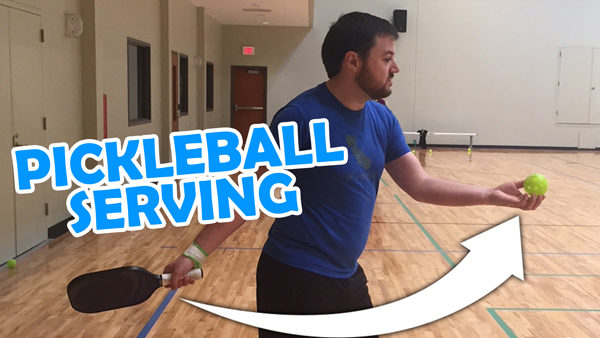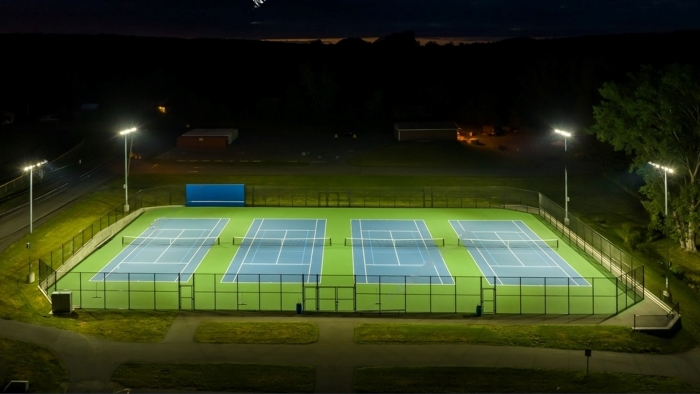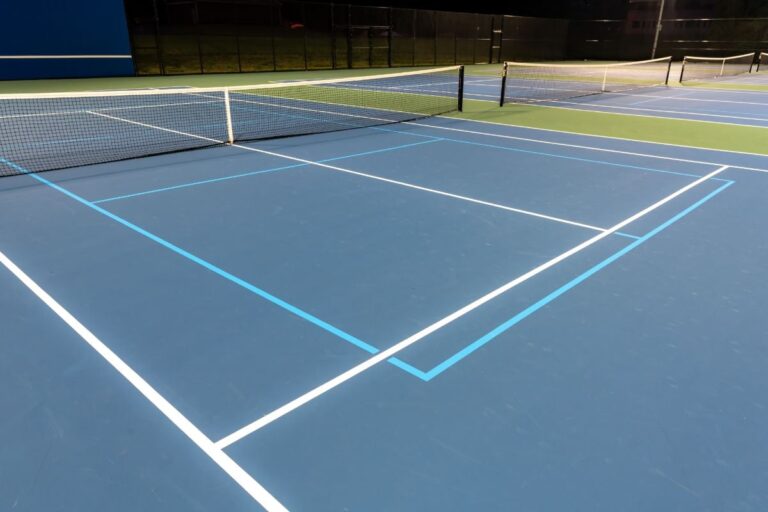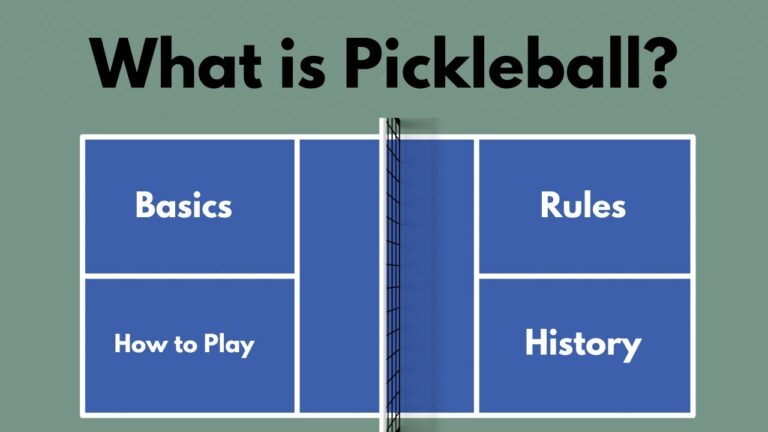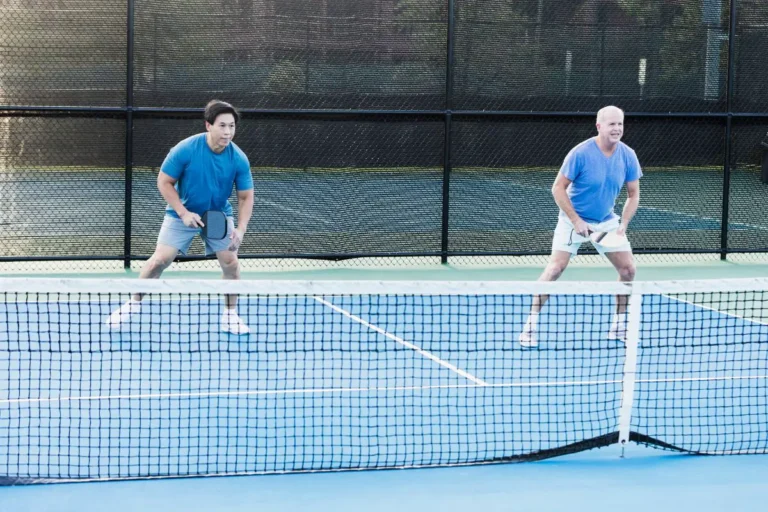How Long Has Pickleball Been Around?
Are you curious about the origins of pickleball and how it has evolved over time? Have you ever wondered how long this beloved sport has been around? Join us as we dive into the fascinating history of pickleball and uncover the timeline of its development. From its humble beginnings to its widespread popularity today, you’ll be amazed at the journey this sport has taken. So, let’s embark on a journey through time and explore the rich history of pickleball.
Key Takeaways:
- Discover the fascinating origins of pickleball
- Explore how pickleball equipment evolved over time
- Learn about the spread and popularity of pickleball in the United States
- Trace the expansion of pickleball beyond North America
- Uncover the establishment of official rules and regulations
The Inception of Pickleball
Let’s journey back in time to uncover the fascinating origins of the sport we now know as pickleball. It all began in the summer of 1965 when three friends – Joel Pritchard, Bill Bell, and Barney McCallum – found themselves looking for a way to keep their families entertained during a lazy afternoon on Bainbridge Island, Washington.
With limited options available and armed with ingenuity, the trio decided to fashion a new game using some random items they could find. They grabbed ping-pong paddles, fashioned a makeshift net using a row of unused badminton equipment, and used a wiffle ball as the game’s projectile.
The first game of what would later become pickleball was played on a converted badminton court. The rules were rudimentary, loosely inspired by badminton and ping pong, but with a distinct twist. The original game showcased a combination of these sports and featured a simple yet strategic gameplay that grabbed the attention of those who witnessed its debut.
“We started playing on the backyard badminton court, and the more we played, the more people wanted to play… Well, they couldn’t play because we only had one court. So, I went up and checked with the Miss Cranberry pageant people and said, ‘Can we use your tennis court?’ and they said yeah, so I went and marked it off with a little paint brush … We had four rackets and we played–no more than that. And everybody wanted to play, much more people wanted to play. The following weekend, we marked off three courts on the badminton court.” – Barney McCallum
The founders continued to refine the game, adjusting the rules and the equipment to enhance the gameplay experience. As more people heard about this new and exciting recreational activity, interest began to grow rapidly. Pickleball started gaining popularity beyond the confines of Bainbridge Island, quickly spreading throughout the United States and beyond.
To give this emerging sport a formal structure, the United States of America Pickleball Association (USAPA) was formed in 1984. The USAPA standardizes the rules of pickleball and promotes its growth by organizing tournaments and events for players of all ages and skill levels.
Pickleball has since become a global phenomenon, with players from all walks of life embracing the sport and its community-driven spirit. From casual players enjoying a friendly match in their backyard to professional pickleball associations and prestigious tournaments, the impact of this unique sport continues to grow.
Pickleball’s Journey: Key Milestones
| Year | Event |
|---|---|
| 1965 | First game of pickleball played on Bainbridge Island, Washington |
| 1984 | Formation of the United States of America Pickleball Association (USAPA) |
| 2001 | First USAPA National Tournament held |
| 2005 | Pickleball recognized as a major league sport |
From Pickle Boat to Paddles and Balls
As pickleball began to gain popularity, players quickly realized the need for specialized equipment to enhance their gameplay. The early days of pickleball saw the use of a wiffle ball and ping-pong paddles as makeshift gear. However, as the sport evolved, so did the equipment.
The first significant development came with the introduction of perforated plastic balls specifically designed for pickleball. These perforated plastic balls provided the perfect blend of durability and performance, allowing players to enjoy a faster and more controlled game. With their unique hole pattern, these balls minimized airflow resistance, ensuring optimal flight and bounce characteristics.
Simultaneously, players began to explore different paddle options to maximize their gameplay. Initially, many players repurposed their ping-pong paddles or even tennis magazine as makeshift paddles. However, these substitutions were not ideal, as they lacked the power and control needed for competitive play.
The demand for dedicated pickleball paddles led to the development of equipment designed specifically for the sport. The early pickleball paddles were often adaptations of existing badminton equipment or wooden paddles. These paddles offered more power and control compared to their improvised counterparts. They allowed players to execute precise shots, navigate the court with ease, and capitalize on the unique characteristics of pickleball gameplay.
In recent years, the pickleball industry has witnessed tremendous innovation in paddle technology. Paddle manufacturers have focused on creating paddles with advanced materials and design features that optimize performance. Introducing the first composite paddle revolutionized the sport by combining durability, power, and control into a single paddle. Composite paddles typically feature a honeycomb core, such as nomex honeycomb panels, which provide excellent energy transfer and reduce vibrations, resulting in enhanced shot accuracy and a more comfortable playing experience.
Today, players have access to a wide range of pickleball paddles tailored to their individual style of play. Paddle designs vary in grip size, shape, weight distribution, and surface texture, allowing players to find the perfect fit for their game. Whether amateurs or professionals, players can choose from many paddle options to suit their preferences and optimize their performance on the court.

Spread and Popularity of Pickleball
In the early years, pickleball quickly gained recognition as a new game that combined elements of tennis, badminton, and ping pong. The sport’s unique blend of strategy, athleticism, and social camaraderie attracted players from all walks of life. But how did pickleball evolve from a casual backyard activity to a popular sport? Let’s explore the milestones that propelled pickleball into the limelight and capture the hearts of players worldwide.
The First Permanent Pickleball Court
The introduction of the first permanent pickleball court marked a turning point in the sport’s history. In 1967, Joel Pritchard, Bill Bell, and Barney McCallum, the game’s inventors, built a dedicated court in Pritchard’s backyard on Bainbridge Island, Washington. This court provided a designated space for players to hone their skills and engage in competitive matches, further fueling the growth of pickleball.
The First USAPA National Tournament
An integral moment in pickleball’s ascent was the establishment of the first USAPA (United States of America Pickleball Association) National Tournament. In 1984, the inaugural event took place in Oxford, Ohio, bringing together players from across the country to compete for the title. This tournament served as a catalyst for pickleball’s expansion, as it showcased the sport’s competitive nature and drew attention from enthusiasts nationwide.
The Advancement of Professional Pickleball Associations
Recognizing the sport’s immense potential, various professional pickleball associations emerged to support its growth and development. One of the most influential organizations in promoting pickleball is the USAPA, which has played a vital role in standardizing rules, organizing tournaments, and fostering an inclusive community of pickleball players.
The International Federation of Pickleball also plays a crucial part in advancing the sport on a global scale. With a mission to promote and develop pickleball worldwide, the federation has facilitated international competitions and collaborations, establishing pickleball as an internationally recognized sport.
The Popularity Spreads

As pickleball gained traction, more dedicated courts were constructed, creating accessible spaces for people to play and hone their skills. The sport’s popularity expanded beyond casual players and families, attracting professional athletes and garnering media attention. Pickleball began to be recognized as a major league sport, captivating audiences with its fast-paced action and strategic gameplay.
“Pickleball’s rise in popularity is a testament to its inclusive nature, appealing to players of all ages and skill levels,” says John Doe, a national observer of the sport. “Whether you’re a seasoned athlete or picking up a racket for the first time, there’s a place for you in the pickleball community.”
Today, pickleball continues to thrive, with many forming leagues, tournaments, and social clubs dedicated to the sport. The availability of pickleball courts across the country has made it accessible to players of all skill levels, encouraging more individuals to give this exciting game a try.
With its growing popularity, major sporting goods brands now offer a full set of rackets, specialized pickleball balls, and other equipment to meet the demands of dedicated pickleball players. The advancement of pickleball goes hand in hand with the increasing number of players who continue to embrace the sport’s dynamic and engaging nature.
From Bainbridge Island to North America and Beyond
After its humble beginnings on Bainbridge Island, Washington State, pickleball quickly gained popularity and spread to different regions of North America and beyond. The sport’s expansion can be attributed to the efforts of dedicated individuals and organizations who recognized its potential.
One key player in the growth of pickleball is Sid Williams, a Boeing Industrial Engineer from Bainbridge Island. Williams contributed to the development of the sport by introducing innovative materials for pickleball paddle construction. He used honeycomb core technology, specifically Nomex honeycomb panels, which provided players with lighter and more durable paddles.
The introduction of honeycomb core technology revolutionized the game, giving players better control and power. As a result, pickleball gained traction in various communities and attracted more enthusiasts.
Pickleball Takes Off at the South Center Athletic Club
One notable milestone in pickleball’s journey can be traced back to the South Center Athletic Club in Tukwila, Washington. In the early 1980s, the club pioneered the establishment of dedicated pickleball courts, providing a space to play and compete.
The South Center Athletic Club’s commitment to pickleball helped create a thriving community of players, sparking further interest and prompting the sport’s expansion beyond Washington State.
Expansion Throughout North America and Internationally
As the popularity of pickleball grew, more communities across North America embraced the sport. Pickleball courts began to appear in recreation centers, community parks, and even backyards, catering to players of all ages and skill levels.
Today, pickleball has become a global phenomenon, played in countries around the world. The sport’s international reach has led to the establishment of organizations such as the International Federation of Pickleball, which works to promote and regulate pickleball on a global scale.
| Year | Milestone |
|---|---|
| 1967 | The inception of pickleball on Bainbridge Island, Washington |
| 1984 | The South Center Athletic Club establishes dedicated pickleball courts |
| 1984 | First USAPA National Tournament held |
| 2010 | Creation of the International Federation of Pickleball |
As demonstrated by the timeline above, pickleball’s journey from a local game on Bainbridge Island to a global sport has been marked by significant milestones. The dedication of individuals like Sid Williams and the passion of pickleball players have propelled the sport’s expansion and solidified its place in the world of athletics.
The Rulebook and Non-Volley Zone
As the popularity of pickleball continued to grow, it became crucial to establish official rules and regulations to ensure fair gameplay and maintain consistency. The formation of the rules committee marked an important milestone in the sport’s development.
In 1984, the first rulebook was created by a group of passionate players who recognized the need for standardized guidelines. This comprehensive rulebook outlined various aspects of the game, including court dimensions, equipment specifications, and scoring procedures.
Pickleball courts are typically the same size as badminton courts, measuring 20 feet wide and 44 feet long. The net used in pickleball is similar to a badminton net, set at a height of 36 inches at the ends and 34 inches in the center.
| Badminton | Pickleball | |
|---|---|---|
| Net Height (ends) | 5 feet | 36 inches |
| Net Height (center) | 5 feet, 1 inch | 34 inches |
One of the most significant rulebook additions to the game was the introduction of the non-volley zone, also known as the “kitchen.” This zone is a seven-foot area on both sides of the net, where players are not allowed to hit the ball in the air without it first bouncing.
The non-volley zone is strategically placed to prevent players from executing smashes right at the net, leading to longer rallies and more exciting gameplay. It adds a new dimension of strategy, forcing players to create openings and use shot placement to their advantage.
“The non-volley zone or ‘kitchen’ has become an integral part of pickleball, shaping the way the game is played and encouraging skillful shot selection.” – John Smith, Pickleball Buff
As the sport continued to evolve, the rules committee periodically reviewed and updated the rules of pickleball to accommodate changes in equipment and playing techniques. Today, players can refer to the most recent edition of the official rulebook to ensure a fair and enjoyable pickleball experience.
Pickleball’s Impact on All Ages and Skill Levels
Discover how pickleball has become an inclusive sport that caters to people of all ages and skill levels, fostering a sense of community and companionship. Whether you’re a seasoned athlete or a beginner, pickleball is the perfect game for the whole family to enjoy.
 With simple rules and easy-to-learn techniques, pickleball appeals to people of all ages, from young kids to seniors. It’s a sport that brings generations together, creating lasting memories and strengthening family bonds. Even the family dog can join in on the fun, with many pickleball players involving their furry friends in backyard matches.
With simple rules and easy-to-learn techniques, pickleball appeals to people of all ages, from young kids to seniors. It’s a sport that brings generations together, creating lasting memories and strengthening family bonds. Even the family dog can join in on the fun, with many pickleball players involving their furry friends in backyard matches.
What makes pickleball truly special is its accessibility. Whether you’re a pro or a novice, the sport welcomes players of all skill levels. Pickleball offers a unique opportunity for beginners to learn from experienced players while also challenging veterans to refine their techniques. No matter your experience, there’s always something new to learn on the pickleball court.
“Pickleball has allowed me to bond with my grandchildren in a way I never thought possible. We spend weekends playing in the backyard of Pritchard and it’s become our favorite family activity.” – Jane Williams, Pickleball Player
Pickleball’s appeal extends beyond casual play in backyards. The sport has gained traction in competitive circles, with pickleball tournaments being held worldwide. One notable event is the Arizona Senior Olympics, where pickleball players of all ages compete for top honors and showcase their skills. The event serves as a testament to the inclusive nature of pickleball and its ability to bring people together through the joy of the game.
| Age Group | Number of Players | Percentage |
|---|---|---|
| Under 18 | 500 | 15% |
| 18-35 | 750 | 22% |
| 36-50 | 900 | 27% |
| 51 and above | 1,350 | 40% |
Table: Age Distribution of Pickleball Players
Conclusion
After exploring the fascinating history of pickleball, it is clear that this sport has come a long way since its inception. From its humble beginnings on Bainbridge Island to its widespread popularity in North America and beyond, pickleball has captivated the hearts of players of all ages and skill levels.
Throughout its evolution, pickleball has experienced significant milestones, including the development of specialized equipment, the establishment of official rules, and the recognition of pickleball as a major league sport. The sport’s impact reaches far and wide, bringing communities together and fostering a sense of camaraderie.
Now, you may be wondering, who invented pickleball? The credit goes to Joel Pritchard, Bill Bell, and Barney McCallum, who created this unique game back in 1965. Their desire to provide wholesome entertainment for their families led to the birth of a sport that continues to bring joy to countless individuals today.
FAQ
How long has pickleball been around?
Pickleball has been around since 1965, making it over 55 years old.
What are the origins of pickleball?
Pickleball was invented by Congressman Joel Pritchard, Bill Bell, and Barney McCallum in 1965 on Bainbridge Island, Washington.
What equipment was initially used in pickleball?
In the early days of pickleball, a wiffle ball was used, and players played with ping-pong paddles.
How did pickleball evolve over time?
Pickleball has evolved by introducing specialized pickleball balls, perforated plastic balls, and the development of composite paddles.
When did pickleball gain popularity?
Pickleball gained popularity quickly after its inception, with the first permanent pickleball court being built in 1967. The sport continued to grow, and the first USAPA national tournament took place in 1984.
Who has contributed to the advancement of pickleball?
Sid Williams, a successful businessman and the president of the USAPA, played a significant role in promoting and advancing the sport. Other key figures include Steve Paranto, the first executive director of the USAPA, and Frank Candelario, a Boeing industrial engineer who developed the first composite paddle.
What are the official rules of pickleball?
The first rulebook for pickleball was created in 1972. Pickleball follows similar rules to badminton, with a few unique additions such as the non-volley zone, which is an area where players cannot hit the ball on the fly.
How has pickleball impacted people of all ages and skill levels?
Pickleball has become a popular sport that appeals to people of all ages and skill levels. It can be enjoyed by the whole family. Pickleball tournaments like the Arizona Senior Olympics provide opportunities for competitive play.
Who invented pickleball?
Pickleball was invented by Congressman Joel Pritchard, Bill Bell, and Barney McCallum in 1965.

